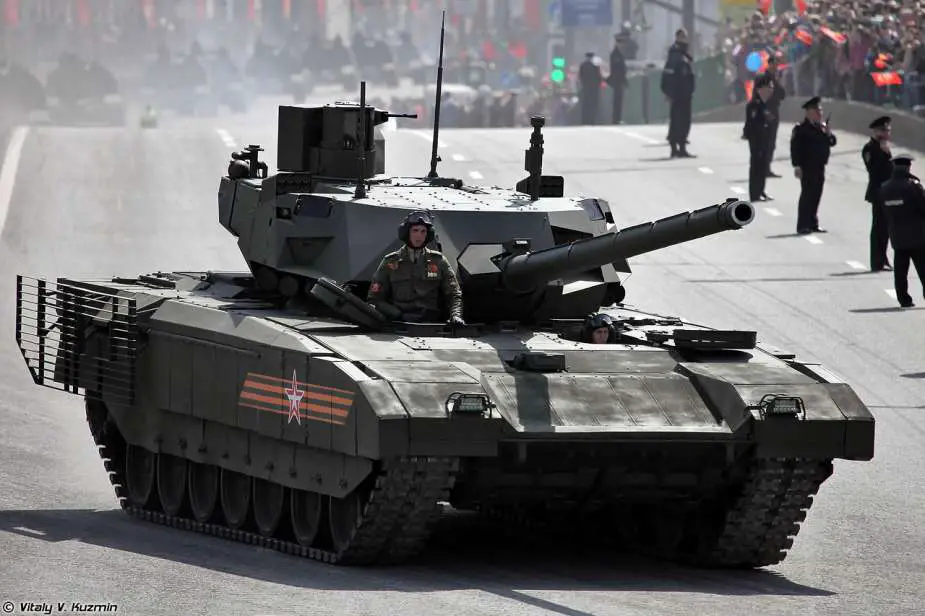Breaking news
British MoD Intelligence Confirms Entry of Latest Generation Russian T-14 Armata Tanks into Service.
According to information released on March 20, 2024, by the British Ministry of Defense (MoD) Intelligence Services, the Russian military has officially brought its latest generation Main Battle Tank, the T-14 Armata, into active service. Despite its introduction, the British MoD has reported that Russia has decided not to deploy the T-14 Armata in the ongoing conflict in Ukraine. This decision is attributed to the high costs of the tank and the potential reputational damage that could result from losing such a prestigious vehicle in combat.
Follow Army Recognition on Google News at this link

The Russian T-14 Armata was unveiled for the first time to the public during a military parade in Moscow, in May 2015. (Picture source Vitaly Kuzmin)
The strategic calculus behind Russia's decision not to deploy the T-14 Armata, its latest generation Main Battle Tank, in the Ukraine conflict, involves a complex consideration of risks, including the significant concern that the tank could be captured by Ukrainian forces. The T-14 Armata, being at the forefront of military technology, embodies a multitude of advanced features that represent a considerable leap in armored vehicle capabilities. Its potential capture on the battlefield would not only represent a tangible loss of this advanced machinery but also pose a severe risk of technology transfer.
Capturing a T-14 Armata would provide Ukrainian forces, and potentially their allies, with unprecedented access to Russian military technology. This could include detailed insights into the Armata's armor composition, its integrated protection systems, the functionality of its unmanned turret, and the advanced communications and targeting systems that it employs. Such information could significantly undermine the technological edge the T-14 Armata is designed to provide, allowing adversaries to develop countermeasures or even reverse-engineer critical components of its design.
Moreover, the loss and potential capture of a T-14 Armata would carry substantial reputational damage for Russia. The Armata is not just a tank; it is a symbol of Russian military modernization and technological prowess. Its capture would not only demonstrate a vulnerability in what is presented as a pinnacle of Russian military equipment but could also erode the perceived superiority of Russian armored forces. In the realm of international military prestige and the psychological aspects of warfare, such an event could have far-reaching implications, potentially affecting the morale of Russian forces and the strategic calculations of allies and adversaries alike.
Therefore, the decision not to deploy the T-14 Armata in Ukraine is not merely about avoiding the financial cost of losing a highly advanced and expensive piece of military hardware. It is also about safeguarding the technological secrets embedded within the Armata and maintaining the prestige of Russian military strength on the global stage. This approach reflects a cautious strategy, weighing the benefits of deploying advanced technology against the potential strategic costs in a highly contested and closely watched conflict.

The T-14 Armata MBT integrates the latest Russian technologies of defense in terms of mobility, protection, and firepower. (Picture source TheWarmy.com)
The T-14 Armata was unveiled to the world during the Moscow Victory Day Parade in 2015, marking a significant leap in Russian armored vehicle design. It represented the first major advancement in Russian tank design in decades and was immediately recognized for its innovative features and potential to redefine battlefield engagements.
The T-14 Armata's design breaks away from previous Russian tank models, featuring a revolutionary unmanned turret. This design choice not only reduces the crew needed to operate the tank but also significantly increases their survivability in combat situations. The crew is housed in an armored capsule in the front of the hull, separate from the ammunition stored in the turret, reducing the risk of catastrophic damage.
Mobility is another hallmark of the T-14 Armata, powered by a new-generation 1,500 horsepower diesel engine that propels it to speeds of up to 80 kilometers per hour on roads. Its advanced suspension system and lightweight composite armor enhance its agility and make it capable of operating across a wide range of terrains, from urban environments to rugged countryside.
The Armata's protection is state-of-the-art, featuring a combination of composite armor, reactive armor, and an active protection system. The active protection system is designed to detect, track, and intercept incoming anti-tank munitions, a feature that significantly enhances its survivability on the battlefield.
In terms of firepower, the T-14 Armata is equipped with a new 125mm smoothbore cannon capable of firing a range of ammunition types, as well as guided missiles. This cannon is complemented by a fully automated loading system, allowing for rapid fire and reduced crew workload. The unmanned turret design permits a larger gun and more ammunition to be carried compared to traditional tank designs.
The T-14 Armata integrates the latest in military technology, including advanced targeting systems, electronic warfare capabilities, and network-centric warfare technology. These systems enhance the tank's situational awareness, allowing it to communicate and coordinate with other units in real time, significantly increasing its effectiveness on the battlefield.
Despite its cutting-edge features and capabilities, the decision not to deploy the T-14 Armata in Ukraine reflects the strategic considerations of cost, potential losses, and the reputational implications for Russia. The tank remains a symbol of Russian military modernization and a key element of its ground forces, but its deployment will likely be reserved for conflicts where its advanced capabilities can be leveraged with minimal risk.
Defense News March 2024


























